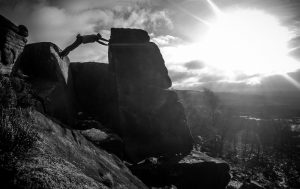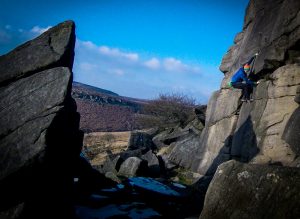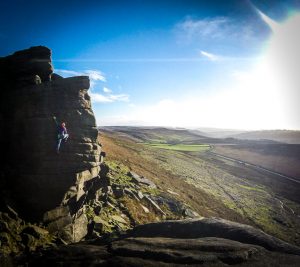Climbing in the sunshine in the magnificent Llanberis Pass, everything feels perfect. I’m climbing a route called “Cemetery Gates”. First climbed by the legendary duo Joe Brown and Don Whillans back in 1951, it’s a great looking line on the impressive yet daunting Dinas Cromlech. A climb that has always been on my wish list since I first started climbing but never really expected to try.
Yet here I was on the second day of a trip to North Wales, feeling tired from both the previous day’s climbing and the steep walk-in to reach the bottom of the route. I felt exhausted and apprehensive before even touching the rock but it only took a few moves into the climb before I started to relax and focus on the climbing and soon I couldn’t stop smiling. Before I knew it I was over 40 metres up and realising that I was past the crux and actually had a good chance of getting to the top – I started to appreciate my surroundings even more. Surrounded by rock and mountains, looking down on the Pass – the exposure was incredible. The fact that I was exhausted didn’t even come into it, I was just focused on the climbing and feeling fantastic, loving the experience.
Sitting at the summit of the climb in the afternoon sun while belaying my friends, I can relax even more, slightly amazed that I made it to the top. However, I can feel my body slowly catching up and reminding me that it’s had to work hard to get me up here.
This isn’t the hardest climb I’ve done, however it’s certainly one of the most memorable & sums up why I love climbing. It’s not just about the actual climbing itself, but the whole adventure – travelling to new places, being in stunning situations, sharing it all with friends and the all-important trip to the pub afterwards.
I was 22 when I discovered rock climbing and was instantly addicted! Speaking to other climbers it was the same for them – but mine isn’t the average story. Before climbing, I had no real interests, was unfit and had no social life – climbing changed my life overnight.
I’ve had Myalgic Encephalomyelitis, otherwise known as M.E for the past 19 years. It’s a multi-system disease affecting not only the neurological system but also the immune, musculoskeletal, endocrine (hormonal) and cardiovascular systems causing a whole host of symptoms which vary from person to person but include persistent exhaustion, aching joints and muscles, chronic migraines, sleep disturbance, hyper-sensitivity to light and sound and cognitive impairment.
The NICE (National Institute for Health and Care Excellence) guidelines state the physical symptoms can be as disabling as multiple sclerosis, systemic lupus erythematosus, rheumatoid arthritis and congestive heart failure. It’s been recognised by the World Health Organisation since 1969 as a distinct organic neurological disorder, however, sadly little is still known about it, not helped by the fact that funding for research is seriously lacking. It’s estimated to affect around 250,000 people in the UK.
There are a lot of negative attitudes towards M.E, it’s a widely misunderstood illness and it doesn’t help that there have been many conflicting (and mostly inaccurate) articles in the press and misleading papers published over the years. It’s not just feeling tired all the time, it’s certainly not laziness and isn’t something that can be cured with happy thoughts and exercise. It’s a devastating, life-changing illness which is a constant daily battle and can affect men, women and children of all ages and leaves most sufferers bed or house bound.
So what’s M.E like?
Have you ever gone to bed one night feeling fine but then woken up with flu? Out of nowhere you’re struck down with illness. Feeling pathetic and useless – completely drained of energy, achey muscles and joints, thumping headache, you can’t think straight, simple tasks feel much harder and you’re generally just feeling like death? Well, that’s kind of close to M.E except instead of feeling better after a couple of days, you don’t. Unlike the flu there aren’t countless medications and remedies available to help ease the symptoms and recover. Instead it gets worse and doesn’t last just days but becomes a constant way of life.
There’s something called the ‘Spoon Theory’ which is often used to explain what it’s like living with an invisible illness like M.E. Personally the spoonies has passed me by, I prefer the battery analogy;
If you think of your energy as a battery, an average person has got a new, fresh, healthy battery which holds its charge well and recharges quickly. You can go out in the day use 20% of energy and after a night’s sleep you’re back at 100% ready to start all over again. Whereas the battery of someone with M.E is completely knackered – it drains ridiculously quickly, takes much longer to charge but never reaches 100% no matter how long you leave it charging. They can go out and have the exact same day, however they use 40% and next morning after a nights sleep they’ve still only re-charged to 60%. They use up their energy quicker than they can recharge it and when it reaches a certain level they relapse.
Unfortunately this all important relapse level is invisible and as soon as it’s reached, M.E knocks you straight to the floor. Not only is the mark invisible, the real kicker is that it keeps moving throughout your illness so you never know exactly where it is – which makes trying to pace yourself near impossible especially as doing ‘too much’ some days can be as little as getting dressed.
Some people may find it hard to imagine that someone suffering from a chronic illness can go out and climb a rock face. When I was at my worst, during the first few years of my illness, I was pretty much housebound. Just getting out of bed, getting dressed and going downstairs would have been a bigger challenge than attempting Everest. Leaving the house, travelling and then walking up to the crag and going climbing for a day would have been totally unimaginable. Thankfully though, I’ve been slowly recovering over the years and my energy levels have greatly increased. It’s taken a while to get to where I am today, it’s been very much a one step forward and three giant leaps back sort of progress.
I still have the majority of my original symptoms but I’m much better at dealing with them and pacing myself. Anyone who knows me knows that my attitude is generally “turn up and do” – although dealing with M.E does mean that I need to try and structure my days as best as I can to make sure I have enough energy to go around and avoid causing a relapse. Unexpected events no matter how small can have a knock-on effect and cause problems.
When I climb rock something awesome happens (no, it’s definitely not skill or flawless technique); I’m not sure if it’s the adrenaline or just the fact that my head’s cleared and focused on the climbing or a mixture of both, but I feel amazing! It sometimes only lasts for a couple of moves, however in that time I forget about M.E and my symptoms and just enjoy the climbing – it’s a brilliant high and the only thing that I’ve found in all these years that helps me to escape even if it’s only for a minute or two.
Climbing is very flexible which is why it suits me. You can do as little or as much as you want and still have a good day out. It’s not just about climbing rocks but the whole experience of being there.
When my symptoms kick up a notch but I’m not too ill, I try and head outside on my own. I usually don’t feel like I have enough energy to meet up and climb with a friend so I go soloing instead. I can set my own pace and climb as much as I’m able. I find soloing completely relaxing, more so than when I’m climbing with a rope. That feeling I get is intensified, I become completely focused on the climbing and the fresh, clean air is brilliant at keeping migraines at bay.
As much as I love climbing, the downside is that it’s completely knackering and I usually end up spending more time recovering than I do on rock. If you see me at a crag I’ll usually be having a great time, having an epic on a route and moaning about the weather – you won’t see my illness and that’s not just because it’s an invisible illness but because when you live with M.E you quickly become a master at pretending to be healthy. I really try my best not to show that side to anyone. It’s not necessarily because I want to hide my illness but more of a coping mechanism and a way to get through the day.
It’s not easy writing about all this. I normally keep my M.E private, it’s not something I talk about or share with anyone. I’m not entirely sure why, maybe it’s just become habit over the years and the way I deal with it.
Positive thinking is a necessity when dealing and coping with M.E, I’ve grown up to always try and focus on the positives no matter how small and on what I can do rather then languish over the negatives and as a result I try not to complain about it. Well actually, I moan all the time but never usually about anything important although I’m known to whinge on about being tired when I’m struggling but I think most people just see it as a common climber’s excuse!
I also don’t want people to think of me any differently or even worse, make allowances. There’s also the stock responses you can get after someone learns you have M.E – “you don’t look ill!!” or the classic “yeah, I was really tired last week too!!” or the people who think you can just snap out of it or that changing your diet or doing exercise will magically cure you. I know most are just trying to help but it really doesn’t.
I’m probably too harsh, after all if I don’t ever talk about it I can’t expect people to understand. I’ve been ill for a long time and it’s shaped my life so when you remove M.E from the conversation there’s not much left to discuss. I feel bad when I’m talking to someone who is sharing their stories and who ask me about my life. I don’t go out of my way to lie but I do avoid mentioning M.E even though it would probably answer a lot of their questions and make me seem slightly less weird and also help explain why I’m so pathetic some days and get tired so quickly or why my brain sometimes turns to mush.
The positive side of becoming ill so young is that I’ve got nothing to compare to, for me this is normal and all I’ve ever known. On a day to day basis I don’t see myself as being ill. Yes I have an illness, however, I don’t see it as a disability – it just is what it is, I just have to accept my limitations and in the great scheme of things I don’t actually have too much to complain about. After all, everybody has their own problems and everyone has challenges in life.
I’ve improved so much over the last few years and I like to believe that I have climbing to thank for that – as a result my life currently revolves around it. I go climbing as much as possible, making the most of good days and when I’m not climbing, I’m crashed out in bed or on the sofa trying to recover and somewhere in between all that I try and fit some work in to pay the bills and fund the next trip. I rarely have spare energy for any other interests so when I say climbing is my life, I really mean it – I eat, sleep and dream it. I know it makes me a bit of a sad bastard but currently it works for me and the positives far outweigh the negatives.
Climbing has changed my life for the better, it gives me a reason to remain positive, something to look forward to on bad days, takes me to amazing places, gives me a way to make friends and socialise and then there’s the actual climbing itself – a totally addictive experience which brings a whole bag full of emotions, challenges, enjoyment, sense of achievement and most importantly of all – epic adventures.
May is M.E awareness month which is why I thought I’d make the effort and share my story. This will hopefully give a small insight into M.E and how climbing helps me live with my illness.





